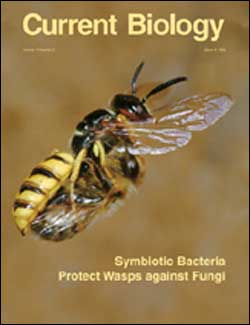Symbiotic bacteria protect hunting wasps from fungal infestation

Researchers have discovered a fascinating symbiotic relationship between a wasp species and a newly discovered bacterial species – a relationship that potentially sheds light on how bacteria can be successfully utilized by higher organisms in defensive mechanisms against other microbes. In the new work, researchers show that a solitary ground-nesting wasp, the European beewolf, harbors Streptomyces bacteria in unique structures within its antennae and that females utilize these bacterial symbionts to protect the wasp larvae against pathogenic fungi.
Detrimental microorganisms are a permanent threat to higher organisms, and because of their high reproductive potential and adaptability, they are extremely difficult to control. Ironically, the best counteragents against microbes are often other microbes that produce very potent antibiotics. Thus, an effective and elegant way to counter the threat caused by bacteria and fungi is to establish a symbiotic relationship with innocuous antibiotic-producing bacteria that provide protection against the most dangerous pathogens. As yet, only a few cases of defensive symbioses between higher organisms and bacteria have been reported.
In their new paper, Martin Kaltenpoth and his colleagues at the Biocenter of the University of Würzburg show that the European beewolf Philanthus triangulum has evolved a defensive symbiosis with a new species of bacteria of the genus Streptomyces. Interestingly, this genus comprises the most important group of bacteria for the production of antibiotics for human medicine.
Female beewolves provision their larvae with paralyzed honeybees in brood cells in the soil. As part of this process, the researchers show, they use their antennae to deliver the symbiotic bacteria to the ceiling of the brood cell before finally closing off the cell. The larvae then take up the bacteria and apply them to the silk threads of their cocoons. The researchers found that experimental removal of the bacteria caused increased fungal infestations and increased larval mortality – in fact, little larval survival – suggesting that the bacteria produce antibiotics that work against pathogenic fungi. These findings broaden our understanding of the evolution and functioning of symbioses that involve protective bacteria, and they may ultimately provide insight into strategies for dealing with antibiotic resistance in our own species’s efforts to combat harmful microbes.
Media Contact
All latest news from the category: Life Sciences and Chemistry
Articles and reports from the Life Sciences and chemistry area deal with applied and basic research into modern biology, chemistry and human medicine.
Valuable information can be found on a range of life sciences fields including bacteriology, biochemistry, bionics, bioinformatics, biophysics, biotechnology, genetics, geobotany, human biology, marine biology, microbiology, molecular biology, cellular biology, zoology, bioinorganic chemistry, microchemistry and environmental chemistry.
Newest articles

Why getting in touch with our ‘gerbil brain’ could help machines listen better
Macquarie University researchers have debunked a 75-year-old theory about how humans determine where sounds are coming from, and it could unlock the secret to creating a next generation of more…

Attosecond core-level spectroscopy reveals real-time molecular dynamics
Chemical reactions are complex mechanisms. Many different dynamical processes are involved, affecting both the electrons and the nucleus of the present atoms. Very often the strongly coupled electron and nuclear…

Free-forming organelles help plants adapt to climate change
Scientists uncover how plants “see” shades of light, temperature. Plants’ ability to sense light and temperature, and their ability to adapt to climate change, hinges on free-forming structures in their…





















